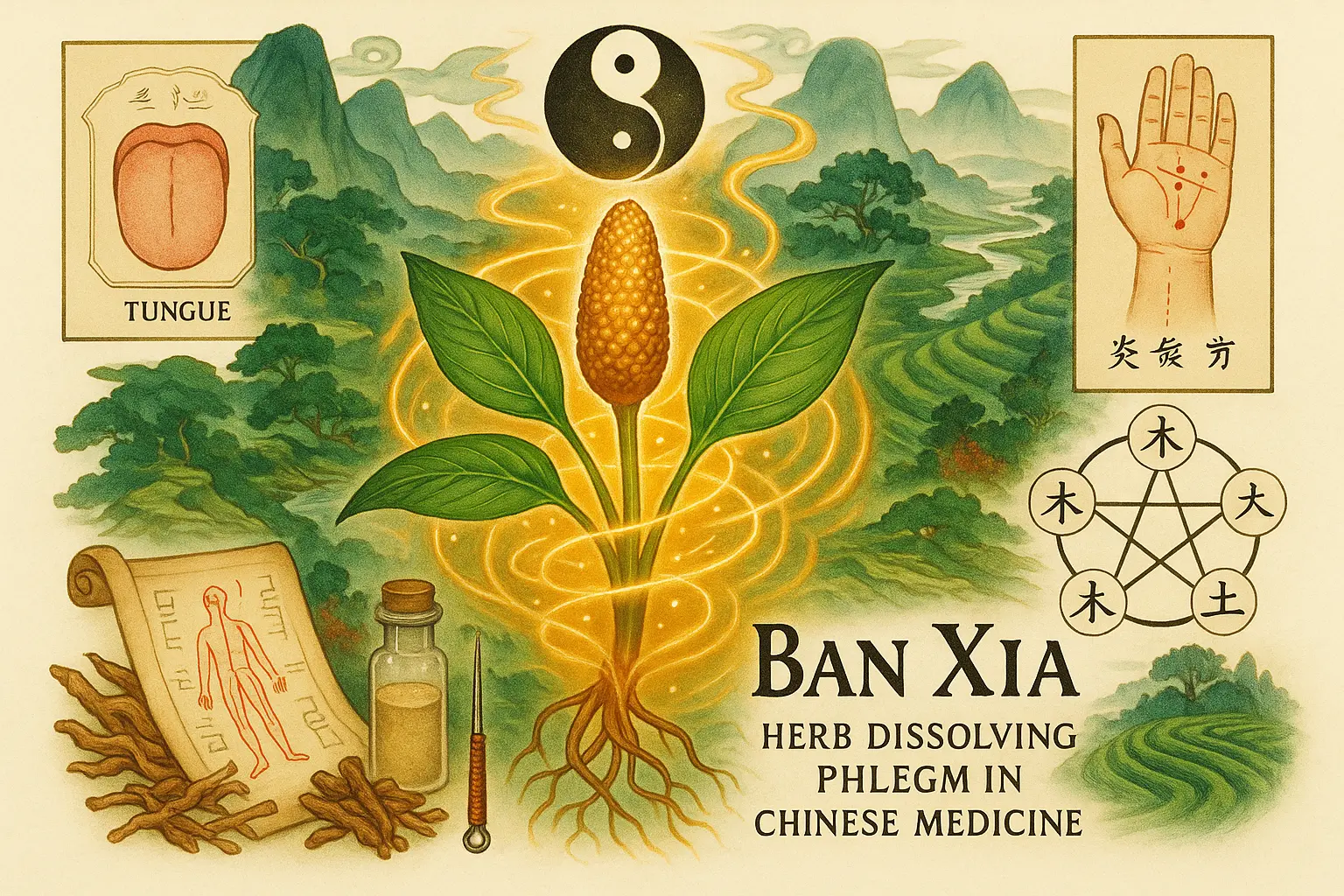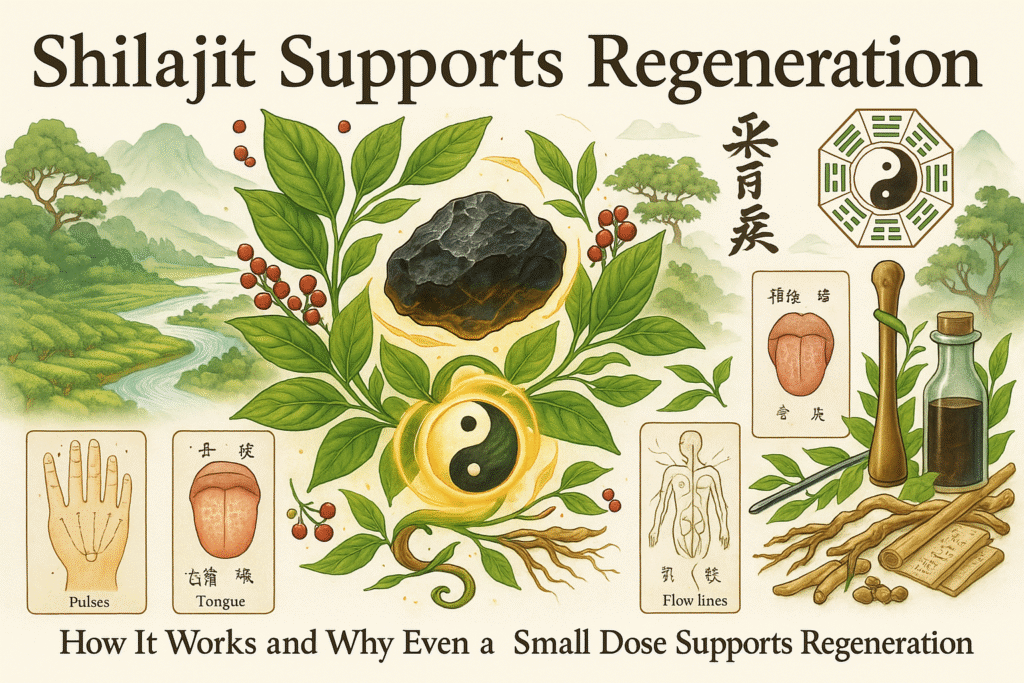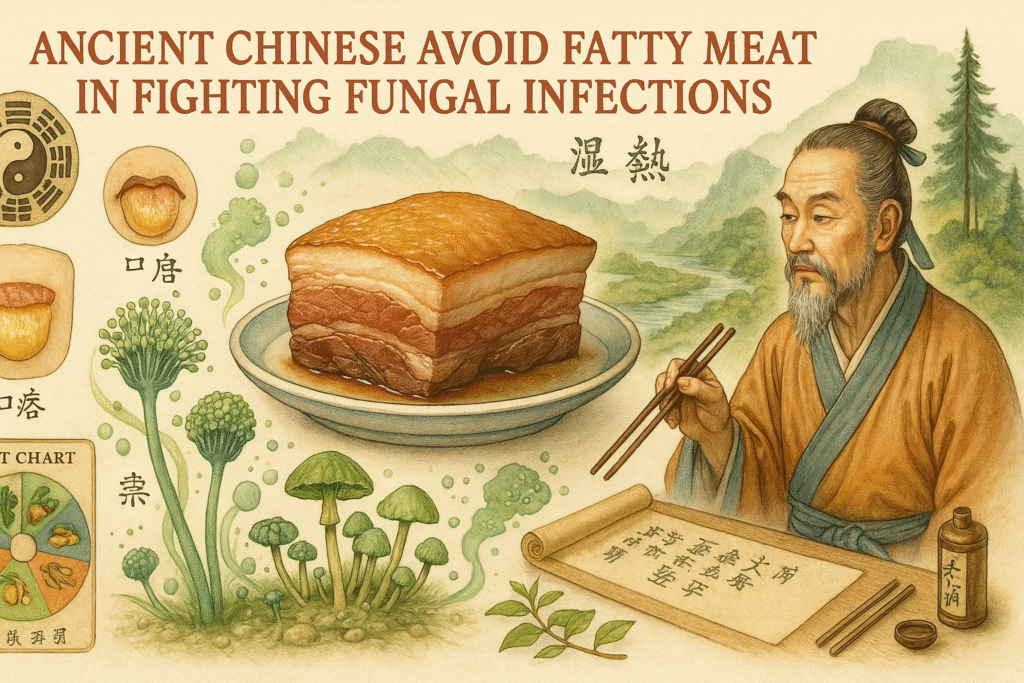Ban Xia (半夏) – Pinellia: The Herb that Dissolves Phlegm and Restores Clarity to Body and Mind 🌿
🌟 Introduction
Welcome to the Awakened Health blog! Today, we’re embarking on an intriguing journey into the world of Banxia (半夏 – Pinelliae Rhizoma preparatum), one of the most important herbs in Traditional Chinese Medicine. This remarkable herb possesses the power to dissolve phlegm and restore clarity not only to the body but also to the mind. Banxia is more than just another herb in the TCM arsenal; it is a true master of transformation, helping people for thousands of years to break free from what blocks their vital energy and clear thinking. 💫
⚠️ Problem: Phlegm Blocking the Body and Mind
Many people struggle with the issue of phlegm that blocks the flow in body and mind. Phlegm is not just mucus in your lungs. It’s a heavy, sticky, stagnating substance that’s hard to expel — and even harder to digest or transform. 😤 In Traditional Chinese Medicine, phlegm (痰 – tán) can:
- 🚫 Block the flow of Qi (vital energy)
- 🔒 Trap unresolved emotions
- 🧠 Interfere with mental clarity and cognitive functions
- ⚙️ Impair the function of internal organs
Banxia addresses this issue directly — by dissolving phlegm, activating Qi, and harmonizing digestion, it helps to cleanse not just the lungs but also the emotional and mental “stickiness” that holds you back. ✨ Have you ever felt like your mind was fogged over? Like your thoughts were too slow and your emotions too heavy? This might be the result of phlegm in your body’s energy system. 🌫️
🔍 What You Will Find in This Article
This article will provide you with comprehensive knowledge about Banxia, helping you understand how this unique herb can support your health and mental clarity. You’ll discover its long-standing use in Chinese medicine and how it can aid in resolving issues with phlegm and energy blockages. This knowledge will help you grasp the natural mechanisms of your body and explore alternative health approaches not found in conventional medicine. 🎯 Particularly useful information for dealing with fungal and bacterial infections like Lyme disease, which form a biofilm.
📑 Table of Contents
- The History and Origin of Banxia in Ancient China
- How Banxia Works in the Body
- Scientific Evidence and Research
- Practical Applications and Protocols
- The Perspective of Traditional Chinese Medicine
- My Personal Experiences with Banxia
- Frequently Asked Questions
- Next Steps and Resources
📚 The History and Origin of Banxia in Ancient China
The history of Banxia dates back over 2000 years, to the Han dynasty, when it was first described in the classic work “Shen Nong Ben Cao Jing” (神农本草经) – the oldest Chinese pharmacopoeia. 📜
🏔️ The Legend of Emperor Shen Nong
According to ancient legend, Emperor Shen Nong (神农), known as the author of the “Divine Farmer’s Materia Medica,” personally tested hundreds of herbs, risking his own life to discover their healing properties. When he encountered Banxia, he immediately noticed its toxicity in raw form, but also its extraordinary power to dissolve what was “stuck” in the body. 👑 The legend goes that Shen Nong 🌿 wandered through the valleys of southern China. It was humid, and thick fogs 🌫️ enveloped the land. Since morning, the emperor felt a similar heaviness in his body – congestion and lingering moisture in his chest, making it difficult to breathe 😮💨.
🧠 How Banxia Works in the Body
Banxia operates within the body through several vital mechanisms, akin to the gentle yet effective “unblocking” of a clogged pipe. Imagine your digestive and respiratory systems as a network of channels through which energy and nutrients should flow freely. 🌊
While wandering, Shen Nong noticed a plant growing densely in the dampest places, where the soil was sticky and heavy, like mud. 🌱 The tubers of Banxia were deeply embedded in the ground, prompting Shen Nong to think:
💭 “If this plant thrives where the soil is suffocated by moisture, perhaps it can disperse what clogs and overwhelms me as well.”
He tasted a piece of the fresh tuber – and immediately felt his throat go numb ⚡, and his breathing became difficult. He realized that this herb was dangerous ☠️.
In the evening, he encountered a village where an old herbalist was collecting the same tubers. Surprised, Shen Nong asked:
“How can you use it if it chokes and poisons?”
The elderly herbalist smiled and replied:
“You see only half of the truth. This herb has a venom, but the venom can be tamed. We cook it long with fresh ginger and purify it in alum. Then its power becomes a remedy – it disperses phlegm and opens the lungs.”
The herbalist offered him a decoction. After a while, Shen Nong felt the heaviness in his chest disperse, his breathing freer, and his throat cleared of the damp mist.
Thus, he discovered that while Banxia in its raw form was perilous, with proper preparation, it becomes one of the most valuable medicines for breathlessness, cough, and chest congestion.
🌿 Traditional Harvesting and Processing
Banxia was traditionally harvested in the warm, humid provinces of Hunan, Sichuan, and Zhejiang during summer when the roots had reached their full potential. The gathering had to be done at dawn when the plant contained the most life essence. 🌅 The processing, known as “pao zhi” (炮制), was a complex ceremony lasting several days:
- 🔥 The roots were first boiled with fresh ginger (Sheng Jiang) for 6-8 hours
- 🧂 Then soaked overnight in an alum solution (Ming Fan)
- ☀️ Dried in the sun for three days
- 🌙 And boiled again under the full moon to enhance their properties
📈 Evolution of Banxia Uses Over the Centuries
During the Tang Dynasty (618-907), Banxia became a critical component in over 200 herbal formulas. The famous physician Sun Simiao (孙思邈) wrote, “Banxia is the key to unlocking what stagnates in the middle warmer of the body.” 🗝️ By the Song Dynasty (960-1279), Banxia was so valued that its price equaled that of silver. Doctors of this era developed detailed protocols dictating when and how to use the herb’s different processed forms. 💎
💧 Mechanism for Banxia in Dissolving Phlegm
Phlegm in Traditional Chinese Medicine (TCM) isn’t just physical mucus; it’s also metabolic “waste” resulting from improper digestion and transformation of bodily fluids or toxins released into the lymphatic system. Banxia acts like a natural “solvent,” changing the structure of this phlegm from sticky to fluid. Imagine phlegm as honey – thick, sticky, and hard to remove. Banxia works like warm water added to honey, causing it to become liquid and easy to eliminate from the body. 🍯➡️💧
⚡ Impact on the Flow of Qi
Banxia: Revitalizing Qi Energy
Qi (氣): This is the life energy that should flow freely throughout the body. When phlegm obstructs the energy channels, Qi stagnates, leading to various ailments. Banxia plays a crucial role in:
- 🔄 Restoring the natural flow of Qi
- ⬆️ Directing energy upwards (which aids in clearing phlegm)
- ⬇️ Calming “rebellious” stomach Qi (which alleviates nausea)
- 🎯 Harmonizing the function of the middle burner (spleen-stomach)
🧘 Effects on Mental Clarity
In Chinese medicine, it is believed that phlegm “clouds” the shen (神) – the spiritual aspect of the heart responsible for consciousness and mental clarity. By dissolving phlegm, Banxia allows the light of awareness to shine again. ✨ This is why people often report greater mental clarity after using formulas containing Banxia, a result of genuinely clearing the “fog” from the mind rather than just a placebo effect. 🌤️
🧪 Scientific Evidence and Research on Banxia
🫁 Expectorant and Antitussive Properties
Reviews of scientific literature show that Banxia exhibits strong antitussive, antiemetic, and anti-inflammatory effects, supporting its traditional use in respiratory and digestive disorders. 🌿
📖 Source: https://pmc.ncbi.nlm.nih.gov/articles/PMC10696046/
🤢 Antiemetic Properties
A 2024 meta-analysis confirmed that the Xiao-Ban-Xia-Tang (XBXT) formula, when combined with standard antiemetics, significantly improves therapy efficacy in chemotherapy patients:
✔️ Reduces nausea and vomiting
✔️ Enhances quality of life
✔️ Reduces therapy side effects
📖 Source: Frontiers in Pharmacology, 2024
Additionally, animal model studies have shown that XBXT protects the gastrointestinal tract from cisplatin-induced damage by reducing reactive oxygen species levels and pro-inflammatory cytokines (IL-1β, IL-18) through NLRP3 inflammasome inhibition. 🧬
📖 Source: PMC7146096
🌙 Influence on Sleep and Quality of Life
Some clinical studies indicate that formulas containing Banxia can enhance sleep, general well-being, and quality of life, while being well-tolerated. 😴✨
📖 Sources: PMC8175169, Wiley Online Library
🌟 Summary
Banxia is a herb celebrated for its ability to clear the “fog” from the mind and dispel dampness from the body. Modern science confirms its effect in reducing coughs, alleviating nausea, and supporting overall balance in the body. This is a beautiful example of how symbolic descriptions by ancient practitioners gain scientific validation today. 🌿
🌱 Practical Applications and Protocols of Banxia
Banxia is most commonly used as part of complex herbal formulas, working synergistically with other herbs to achieve enhanced effects. Here are the key uses and protocols: 📋
🍜 Essential Formulas with Banxia
**Er Chen Tang (二陈汤) – Two Aged Decoction** This classic formula is used for “drying dampness and dissolving phlegm”:
- 🌿 Banxia (Pinellia) – main ingredient – dissolves phlegm
- 🍊 Chen Pi (tangerine peel) – moves Qi
- ☁️ Fu Ling (Poria) – drains dampness
- 🫚 Gan Cao (licorice) – harmonizes the formula
**Xiao Chai Hu Tang (小柴胡汤) – Minor Bupleurum Decoction** A renowned formula for harmonizing and clearing:
- 🌿 Banxia – dissolves phlegm
- 🌾 Chai Hu (Bupleurum) – moves liver Qi
- 🍯 Huang Qin (Scutellaria) – clears toxic heat (toxins)
- 🥄 Gan Jiang (dried ginger) – warms the middle
⏰ Dosing and Timing Protocols
Traditional preparation of the decoction:
Banxia is never administered alone; it is always included in formulas.
- 🥄 6-12g processed Banxia per daily dose
- 💧 Boil in 500ml water for 20-30 minutes
- 🍵 Divide into 2-3 portions, drink between meals
- ⏱️ Best taken 2 hours after eating
Important safety guidelines:
- ⚠️ NEVER use raw Banxia – it is toxic
- 🤰 Avoid during pregnancy and breastfeeding
- 💊 Maintain at least 2-hour intervals from other medications
- 🍯 Do not combine with honey (traditional contraindication)
🎯 Specific Indications for Banxia Uses
Banxia can support the body in the following situations:
Digestive issues:
- 🤢 Nausea and tendency to vomit
- 💨 Bloating and feeling of fullness
- 🔄 Slow digestion
- 💧 Excessive saliva production
Respiratory problems:
- 🫁 Chronic cough with phlegm
- 😮💨 Shortness of breath related to phlegm
- 🌫️ Feeling of “fog” in the lungs
- 💤 Breathing issues during sleep
Emotional and mental issues:
- 🌫️ Mental fog and reduced concentration
- 😴 Feeling of heaviness and apathy
- 🔄 Obsessive thoughts
- ⚖️ Mood swings linked to digestion
🌿 Traditional Chinese Medicine Perspective on Banxia
In traditional Chinese medicine (TCM), Banxia is regarded as the “minister of phlegm” – an herb with a special ability to dissolve and transform what’s stagnant in the body. 👑
⚖️ Energetic Properties of Banxia
Nature: Warm (温 – wēn)
Taste: Pungent, bitter (辛苦 – xīn kǔ)
Meridian: Spleen, stomach, lungs (脾胃肺 – pí wèi fèi)
Direction of action: Upward and inward
Banxia is like an experienced conductor who can coordinate the action of various organs to restore harmony in the body. Its warm nature helps “dry” excess dampness, while its pungent taste activates stagnant Qi. 🎼
🏮 Concept of the “Middle Burner”
Understanding Banxia in Traditional Chinese Medicine
In Traditional Chinese Medicine (TCM), the body is divided into three “heaters” (三焦 – sānjiāo). Banxia is particularly supportive of the middle heater, which includes the spleen and stomach, the organs responsible for digestion and the transformation of food into Qi and blood. When the middle heater is weak, phlegm develops. It’s akin to trying to cook on a low flame—food isn’t properly prepared and starts to spoil. Banxia helps to “ignite the fire” of digestion and restore proper transformation. 🔥
🎯 How TCM Transformed My Health Perspective
My 3.5 years of studying Chinese medicine completely revolutionized my understanding of health. Instead of viewing symptoms as isolated issues to “combat,” I learned to see them as signs of disharmony within the body. 📚 Over months, Banxia was my savior, teaching me that true health isn’t just the absence of symptoms but a dynamic balance—the smooth flow of energy, emotions, and substances throughout the body. This approach helped me understand my health challenges in a totally new light. ✨
My Personal Experiences with Banxia
I had the opportunity to use Banxia (半夏 – Pinelliae Rhizoma preparatum, prepared pinellia) for an extended period, in various formulas and protocols. This allowed me to observe its effects clearly and subtly in different contexts. 🔍 One consistent result was that the phlegm became less sticky, transforming from something glue-like to a more fluid state, easier to clear and less bothersome. 💧 This transformation was noticeable in my saliva, which changed from thick to foamy.
Clearing phlegm from my body was a long and challenging process, lasting several months. It was persistent and returned often, highly dependent on my diet. I had to eliminate sugar, gluten, dairy, and fats, relying mainly on millet for many weeks.
🍚 Banxia was a constant companion throughout this journey—a silent support helping me gradually purify what was lodged within me for too long. For this, I am deeply grateful.
🙏 What worked: Regular use in the form of Er Chen Tang, especially on an empty stomach in the morning, significantly improved phlegm mobility and made it easier to expel.
What didn’t work as well: Trying to speed up the process by increasing the dose—my body needed time for gradual transformation. One thing I learned through firsthand experience is that Banxia requires patience and consistency—it’s not a “quick fix” but a deep transformation. ⏳
❓ Frequently Asked Questions About Banxia
🤔 Is Banxia Safe for Long-Term Use?
Processed Banxia is generally safe for long-term use under proper supervision, but it requires adherence to correct dosages and protocols. The raw form should never be used as it is toxic. Always consult with a TCM practitioner before prolonged use.
💊 Can Banxia Interact with Medications?
Banxia may affect the absorption of certain medications due to its binding properties. Always maintain a minimum two-hour gap between taking Banxia and other medications. Pay particular attention when taking heart or anticoagulant medications.
🤰 Can I Use Banxia During Pregnancy?
No, Banxia is contraindicated during pregnancy and breastfeeding as it can stimulate uterine contractions and may be harmful to the developing fetus.
⏰ How Long Does it Take to See Results with Banxia?
✨ Next Steps and Resources
The initial effects of Banxia, such as improved digestion and reduced nausea, can be noticeable within minutes with a large dose. However, significant changes in phlegm structure and mental clarity typically require 4-8 weeks of consistent use.
🍯 Why You Should Not Combine Banxia with Honey
According to Traditional Chinese Medicine, honey can neutralize the properties of Banxia or even create adverse reactions. This principle has been adhered to for thousands of years, though modern science has yet to fully explain the mechanism behind this interaction.
✨ Steps to Optimize Banxia Uses for Your Health
If this article has helped you understand the potential of Banxia in supporting your health, here are specific actions you can take: 🎯 Key Takeaways:
- 🌿 Banxia is a powerful tool for dissolving phlegm on multiple levels
- ⚠️ Always use only the processed form from trusted suppliers
- 👨⚕️ Consult with a TCM practitioner before beginning usage
- ⏳ Be patient – true transformation takes time
- 🥗 Support Banxia’s effects with an appropriate diet (avoid sugar and excessive fats)
Next Steps:
- 🔍 Find a qualified Chinese medicine practitioner in your area
- 📖 Deepen your knowledge of TCM and holistic health approaches
- 🌱 Consider incorporating other supportive practices (qigong, acupuncture)
- 📝 Keep a journal of symptoms and progress
Legal Note: All content provided on this site is for informational purposes only and does not constitute medical advice. It cannot replace consulting or treatment by a doctor or another qualified healthcare professional.


